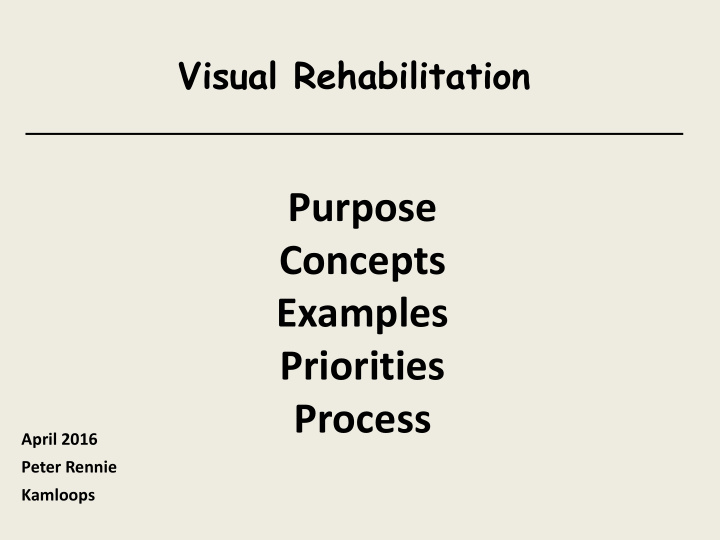



Visual Rehabilitation Purpose Concepts Examples Priorities Process April 2016 Peter Rennie Kamloops
Visual Rehabilitation Purpose: Visual rehab is concerned with improving the visual quality of existing man-made alterations by finding ways to make them appear more natural. Concept can be applied to mines, roads, gravel pits, harvesting, utility corridors, structures, etc. Forestry context: Reshaping cutblock shapes and boundaries • Recontouring and revegetating roads, landings, borrow • pits, other site disturbances Cleaning or removing negative features such as heavy • slash accumulations or slash piles, windthrown trees, etc. (usually in foreground views) Encouraging rapid greenup through various strategies •
Visual Rehabilitation Examples Issue: straight upper boundaries conflict with natural features. Objective: create irregular edges and vertical orientation to tie in with surrounding natural features. Digital Terrain Model DTM overlay on photo Before Visual rehab simulation Landscape analysis
Visual Rehabilitation Examples Issue: horizontal orientation of openings cut across vertical ridges and slide tracks of upper slopes. Objective: visually tie upper opening to natural features and connect openings. Before – close up Before Landscape analysis After
Visual Rehabilitation Examples Issue: straight vertical boundary is focal and conflicts with ridge line. Objective: break up vertical opening boundary and thinly treed skyline. Visual rehab simulation Before Landscape analysis After
Visual Rehabilitation Examples Issue: straight private lot boundaries do not blend. Objective: break up angular boundaries with adjacent retention cuts and connect openings.
Visual Rehabilitation Examples Issue: geometric shape & straight boundaries do not blend. Objective: break up angular boundaries with adjacent small harvest areas and connect openings for less fragmented effect. Before – Aug.1997 After - Aug.2000 After – Aug.2005
Visual Rehabilitation Examples Issue: stacked, geometric shapes with even spacing. Objective: break up straight, horizontal boundaries and connect openings with adjacent harvesting, leaving retention clumps for texture/structure. Before – 2001 After – 2001 Close-up leave patches
Visual Rehabilitation Examples Issue: geometric shapes and straight upper boundaries do not blend. Objective: break up boundaries with small vertical cuts that tie in with leave patches and follow visual force lines.
Visual Rehabilitation Priority Areas: VQOs of R, PR, and M; and • Viewed within 8 km of communities, • highways, or recreational lakes; and Clearly visible geometric opening • shapes, preferably multiple existing openings; and Harvested within past 10-12 years; and • Adjacent stands of similar quality; and • Existing usable road network •
Visual Rehabilitation Process: Identify candidate area • Assemble information: visual • condition, VQOs, other overlapping values, access, harvest opportunities Analyze landscape and design issues • Prepare design option(s) with • simulations Select preferred option • Prepare VIA package with rationale • Request exemption (from VQO) with • supporting information.
FREP Provincial Results: VQO Achievement: •
FREP VQO Achievement: By Area. •
FREP Provincial Results: Provincial Results: Visual Design: Tree Retention: • •
FREP Provincial Results: Consistency with VQOs is 69% Provincially, and 18 of 24 districts are • achieving below 80%. In South Area 5 of 8 districts are achieving below 60%. Retention VQOs were achieved in 56% of samples, Partial Retention • 64%, and Modification 80%. There is room for significant improvement on our most sensitive landscapes. Application of visual design principles is slipping. Only 35% of • samples were well designed (down from 40% in previous reporting out). Visually effective tree retention has dropped from 22% of samples • to 13% since last reporting out.
Recommend
More recommend